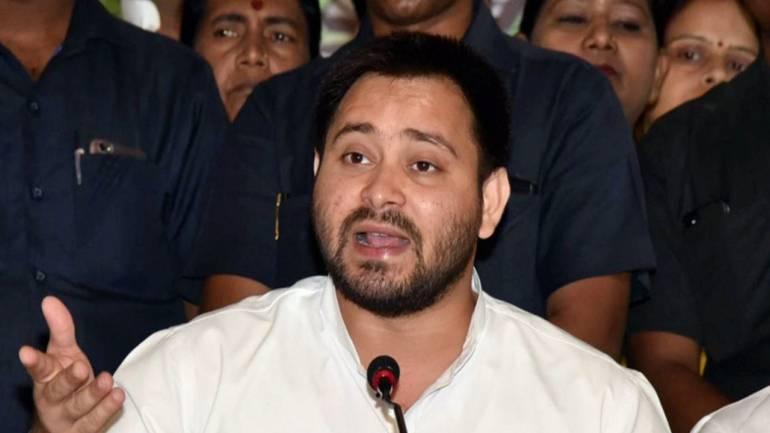Decoding the Fall of Mahagathbandhan in Bihar

Image Courtesy: Money Control
This was the first time the Rashtriya Janata Dal (RJD) was on the electoral battleground without its supremo Lalu Prasad Yadav. Political analysts were of the view that the party, riding on anti-incumbency and citing Chief Minister Nitish Kumar’s back-stabbing, would make gains in the state. In contrast, the party, this time led by Lalu Prasad’s younger son Tejashwi Yadav, recorded its worst performance in parliamentary elections since its decadal reign. In a first, RJD has been reduced to zero in the Lok Sabha elections 2019.
Lack of Vision
In these elections, the RJD failed to put a good roadmap for development and its vision for a progressive Bihar was missing. The party’s campaign was completely focused on verbal bashing and public criticism of the Central and state governments. None of the Mahagathbandhan candidates in their speeches and outreach succeeded in pushing voters outside of BJP’s trajectory. It was a campaign without any robust vision.
The tenure of Tejashwi Yadav as Deputy CM attracted CBI investigation on a case related to alleged money laundering in granting the operational contract of two IRCTC hotels to a private firm. This helped the Bharatiya Janata Party (BJP) in projecting a corrupt image of the Yadav family among voters. This is also a key reason why RJD couldn’t convert its Assembly win into political capital for the parliamentary elections. The Janata Dal (United), with its secular identity (despite allying with the BJP) and Nitish Kumar’s ‘clean’ image attracted voters belonging to the upper caste and middle class Hindus who may not have voted for RJD without the JD(U) as a partner.
Also, BJP rebel leaders, such as Kirti Jha Azad, Shatrughan Sinha and Uday Singh, were given tickets by the Mahagathbandhan sidelining competent local leaders. Parachute candidates with previous ideological segregation were not well received by the electorate.
The party also fielded notorious criminal and ex-MP Mohd Shahabuddin’s wife, Heena Shahab, from Siwan and Vibha Devi, wife of expelled party MLA Rajballabh Yadav, who was convicted of raping a minor girl from Nawada. This irked the people.
‘Incompetent’ Successors
When asked about Tejashwi Yadav’s rallies, many participants were quoted a saying: “Sahar me rahni han tah aa gaeni haan inka dekhe, vote ta Modi ji ke jai.” (Our votes will go to Mr Modi, we just came here to see him.)” In Begusarai, some rally participants told BBC Hindi that Modi would win in Bihar and they only had come to see Tejashwi’s helicopter. The party was measuring voter turnout by the crowds in its rallies. If it was not a huge mistake on the part of the party’s leadership, then certainly a poor tabulation.
Commenting on dynastic politics, Nalin Varma, Lalu Prasad Yadav’s’s biographer, said: “If people have rejected ‘dynastic’ rule, why has Jagan Mohan Reddy swept polls in Andhra Pradesh even breaking his father YSR’s records? Why has Varun Gandhi won?”
Varma somewhere seemed to have missed the central notion. Dynasty is also about competence (though Jagan Reddy is yet to prove that in Andhra Pradesh). It can be said by naysayers that Jawaharlal Nehru thrived because of his father, but Nehru was also a self-made man. Motilal Nehru didn’t help him resist the British or agitate for the cause of oppressed Indians. His letters written from jail were products of his brilliance and experience.
The image of Jagan Reddy and Varun Gandhi has some ground presence. Reddy doesn’t hesitate to reach out to voters. In 2013, he went to meet cyclone-hit farmers in Godavari East and was seen standing with his feet in the mud. He continued his connectivity programme. In 2018, his two-way communication with dalits in Krishna district won hearts. Voters across the state, seeing a politician interacting with locals for hours, were influenced, which certainly boosted Reddy’s image.
Mahagathbandhan constituent, Rashtriya Moktantrik Samta Party fielded a newbie, Akash Singh, son of former minister Akhilesh Singh, from Purvi Champaran. He lost the seat to BJP’s Radhan Mohan Singh by a margin of two lakh votes. In the adjacent constituency of Paschim Champaran, Sanjay Jaiswal, who also happens to be the son of a former parliamentarian, won with a margin of three lakh votes. This is his third consecutive term.
This indicates that ‘incompetent’ dynasts were a big ‘No’ in Bihar this time.
The RJD, unwilling to build an alliance in Begusarai, never thought that this would cost it dearly, as its candidate, Tanweer Hassan, ranked a distant third. This was just an attempt by the Yadav family to stop CPI candidate Kanhaiya Kumar from dismantling their dynastic fortress, as he is seen as an able leader with the potential to become a new face in Bihar’s politics.
Modi’s ‘Nationalism’
The BJP’s vote propulsion was completely based on its national narrative on internal security, scheme incentives and Modi’s ‘nationalist’ image. Local agrarian distress, caste-based marginalization and development were absent from the BJP’s poll agenda.
On polling day, some women voters near Hariwatika, Bettiah, were quoted as saying: “Desh rahi tabe kuch hui nu. Dekhni ha Modi kaise ghar me ghus kar mara hai?(the country has to first remain intact. Did you see how Modi did the surgical strike?)
Indrajeet Jha, HT Media’s Champaran correspondent, was of the view that BJP’s prime focus was on nationalism which helped unite the voters, independent of their dogmas and beliefs.
With the advent of mobile technology, the BJP circulated videos of Modi’s speeches on the Pulwama fallout which emotionally targeted a significant number of voters.
Bihar’s regional parties failed to counter this. Even Nitish Kumar’s failure to secure Special Status for Bihar, was not made an issue.
This election season also came with some academic perspectives surrounding general elections. ‘Anonymous voter’ was one of terms used by the India media. But, anonymous voting was certainly not a situation in Bihar which nullified the statistical difference between the exit polls and final outcome.
The BJP’s national narrative and Modi’s identity politics were systematically entrenched among voters.
Hindutva Mobilisation
Several psephologists have termed the Modi wave as synonymous to the Hindutva wave. This analogy could be termed flawed as far as BJP’s apparent politics is concerned, but the Hindu-Muslim divide did obviously helped BJP in getting a landslide victory in these elections.
The Rashtriya Swayamsevak Sangh’s (RSS) education wing, Vidya Bharati, through its widespread schools across the state, immensely helped BJP create homogeneity among Hindus with the books on Hindu nationalist versions of social sciences written by Dinanath Batra. Young voters, independent of caste, are under the strong influence of the Hindu nationalist ideology of Jagadguru Hindu Rashtra.
A toxic politicisation of Hindu festivals, such as Saraswati Puja, Dussehra and Ram Navami, has been observed recently. A report by NewsClick highlights how Islamophobic slogans and aggressive posturing led to communal clashes in Bhagalpur, Munger, Samastipur, Siwan, Gaya, Aurangabad and Nalanda districts of Bihar last year. These were allegedly executed ahead of the general elections to polarise votes on religious grounds.
One of badly affected districts– Bhagalpur– suffered a conflagration as BJP, RSS and Bajrang Dal workers took out an unauthorised procession led by Union Minister Ashwini Choubey’s son Arijit Shashwat to mark ‘Vikram Samvat’ – the Hindu New Year. The procession, organised by Bharatiya Navvarsh Jagran Samiti, passed through a 15-km route, which included at least half-a-dozen Muslim-majority areas.
The only insignificant trouble for BJP is Muslims who can’t do anything politically with their minor presence. This is why BJP doesn’t field any candidate from Kishanganj where Muslims constitute 67% of the population. The JD(U), with its secular image, put up a Muslim Kishanganj in Lok Sabha 2019 who lost to Congress’ Mohammed Javed by a thin margin.
Read Also: Muslim-Dominated Kishanganj Backs Congress, Rejects AIMIM
The anti-BJP bloc couldn’t retain Mehboob Ali Kaiser, a prominent Muslim face in Bihar politics. With Kaiser as a candidate from Khagaria, the Lok Janashakti Party, succeeded against RJD. Also note, Khagaria has 10% Muslim population.
The RJD, in order to appease upper caste Hindus, failed to address religious mobilisation by RSS-BJP-backed fringe groups. Also, Congress inducted Kirti Azad of BJP against the consent of minorities who have accused his father and former CM of Bihar, Bhagwat Jha Azad, for the Bhagalpur riots of 1989. This caused a split among Muslims who still await justice. The appropriation of Shatrughan Sinha as a Mahagathbandhan’s parachute candidate was also denounced as he was once a staunch supporter of BJP-RSS. Sinha was seen accompanying LK Advani in his divisive Ram Mandir Rath Yatra of 1990s as film-maker Anand Patwardhan documents in ‘Ram Ke Naam’.
With BJP’s muscular nationalism in action, Hindu nationalism also acted as a decisive catalyst that the Opposition failed to counter.
Caste Fostered, Class Ignored
Naresh Ram, a Dalit from Sareya Ojhwalia village of Bairia tehsil, who traditionally voted for RJD, told NewsClick post-election that he didn’t do so this time. He said, “Modi vikas purush hauyen. Ab inka vote deweke tah bant rahe. Aur kaun ba race mein? (Modi is development hero. He deserved the vote. Who else was in the competition?)” Naresh belongs to a lower middle class family.
Like Naresh, lakhs of voters from the marginalised castes voted for BJP, has a significant representation of dalits in its Bihar cadre.
People in Bihar voted independent of caste and creed, except for Muslims who face a threat from Hindu extremists, thus limiting RJD to the Yadav and Muslim vote bank. Even Kushwaha’s votes did not work.
In Madhepura, which is known as a Yadav bastion, RJD’s candidate Sharad Yadav-- a four-time MP from the same seat -- lost to Dinesh Yadav of BJP by a margin of three lakh votes. This simply means that Yadavs didn’t even vote en bloc for RJD, considered an umbrella party of Yadavs.
Lalu Prasad was always a champion of the oppressed castes. In 1990, he called for revolution against casteism. He said, “Bhu-Ra Ba-L saaf karo. (Clean Bhu(mihar)-Raj(put) Ba(bhan/Brahmin)-L(ala/Kayastha).)
Tejashwi Yadav, following in his father’s footsteps, loosely pledged unity among the oppressed castes. The party never thought that the class phenonemon could play an important role. It failed to recognise the aspirations of a rising middle. Castes in Bihar today have an organic solidarity among themselves. This sociological phenonemon was completely neglected by the RJD-led Mahagathbandhan, which stuck to its old caste-mathematics.
The reason behind the Opposition’s defeat in Bihar is the opposition itself, which failed to project a credible alternative to a divisive and tactical BJP.
The writer is an independent journalist and serves as an editor at Academia.edu. He writes on social inequality and rights in India.
Get the latest reports & analysis with people's perspective on Protests, movements & deep analytical videos, discussions of the current affairs in your Telegram app. Subscribe to NewsClick's Telegram channel & get Real-Time updates on stories, as they get published on our website.























